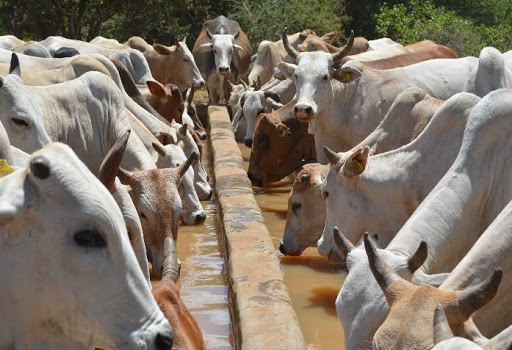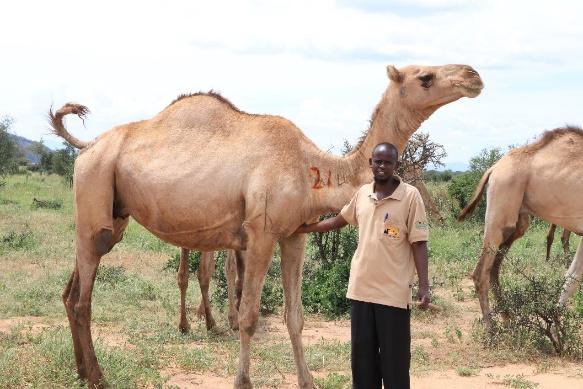Capacity building through peer-to-peer learning: a way to adapt to local changes in Kenya

By Alemayehu Zewdie
The ASSAR project in East Africa seeks to translate research into impact through a Research-into-Use (RiU) approach. This involves continuous engagement, partnership, and collaboration with key stakeholders on different adaptation issues.
In East Africa, ASSAR has been exploring the main problems related to climate change facing communities living in the semi-arid drylands. We have also been evaluating the available options for addressing these through Participatory Scenario Analysis (PSA).
ASSAR learned that pastoral communities in Isiolo county, Kenya, view pasture scarcity as a major constraint to their livelihoods. These communities rely to a large extent on extensive livestock production for their wellbeing. ASSAR thus developed an impact pathway that defined research activities, outputs, outcomes and overall impact to guide research and capacity building activities to help cope with pasture scarcity in Kenya’s drylands.
The ASSAR team conducted a series of workshop with local communities in Isiolo, which involved discussing issues around pasture scarcity from their perspectives and experiences. Following these workshops, we organised a peer-to-peer (P2P) learning exchange to equip pastoralists with skills to better deal with pasture scarcity. Participants learned from others in the area about the traditional land management system, known as Dedha, and camel-rearing. The process was supported by a Grant for Local Adaptation Support (GLAS) from START.
Goals of P2P

Following a series of PSA workshops, the P2P learning exercise in Kenya was proposed to promote sharing of knowledge, skills, experiences and best practices among communities -- specifically with respect to the priority of addressing pasture scarcity in pastoral dryland areas. Additionally, the exercise aimed to increase the capacity of communities to pursue sustainable adaptation pathways, and capacitate influential actors to advocate for sustainable and equitable access to pasture resources.
Seven people from each PSA study site (Kinna, Kulamawe and Kachiuru) in Isiolo county took part in the P2P exchange, making for a total of 21 participants. To ensure representation of groups who often don’t have a voice in community-level decision-making, we involved a spectrum of participants. They included old men, young men, old women, and young women.
The P2P learning exercise aimed to:
-
Expose participants to experiences and lessons learned in implementing the customary institutions of natural resource management.
-
Impart skills for camel-rearing (feeding, breeding, disease detection and control) since camels cope better than cattle in times of drought; increase awareness of market opportunities for camel and camel products; and share skills related to value addition for camel products.
-
Impart knowledge about grass species suitable for semi-arid areas; share skills on pasture re-seeding and agronomic practices, fodder harvesting, and post-harvest handling and storage; raise awareness of available fodder markets.
The P2P exchange took place over three days.
Day one: Customary natural resource management

In this activity, participants started with a presentation on customary institutions of natural resource management (known as Dedha in Borana) that has been revitalised by the Borana community in the Kinna ward of Isiolo County. It was an opportunity for participants from elsewhere to learn about the Dedha system, which promotes zoning of grazing land into wet season, dry season and drought grazing areas. A council of elders (jars dedha) regulates the use of these zones to ensure sustainable management of grazing and water resources. In the past, the Dedha system was effective in regulating pasture use in the area, but it has recently been undermined due to several endogenous and exogenous factors. The community has already developed a draft customary natural resource management bill that is awaiting enactment by the County Assembly. The council of elders shared their experiences, lessons they have learned, challenges, and opportunities with participants from Kulamawe and Kachiuru (themselves Boranas).
Day two: Camel value chain

This activity exposed participants to camel husbandry practices and an understanding of the entire camel value chain. It also served the purpose of linking the communities to the Kenya Camel Association (KCA) for future technical backstopping and other services concerning camel production. In the morning session, an expert from KCA gave a presentation on the increasing adoption of camels by communities in the drylands that are not traditional camel keepers. The afternoon was dedicated to questions and answers, as well as sharing of experiences among participants, since some of the community members had already embraced camel rearing. This activity was facilitated by the national representative for the KCA, who also shared a camel husbandry manual with participants.
Day three: Fodder production and preservation
The field visit to fodder farm Bisil, in Kajiado County, was preceded by a presentation from the Kenya Agricultural and Livestock Research Organization (KARLO) on the common range grass species, their production and agronomic practices, as well as harvesting and marketing aspects. Following the morning presentations, participants had a chance to learn first-hand from a commercial fodder farmer, and others, about fodder production and preservation practices. The main learning was that individuals and groups who practice fodder production in the drylands not only do it to preserve pasture to sustain their herds during dry periods, but also as a way of diversifying their sources of income by selling surplus hay and seeds.
Participants keen to take action
The P2P learning exchange was a great experience for all participants, including the organisers. It offered an effective way for people to learn from their peers and experts through sharing knowledge, skills, and experiences. The experience has already resulted in some indications of change in attitudes, with participants aiming to follow through with actions. Some of these sentiments are expressed below:
-
“...we have learned a lot during the four days of tour. From what I have seen, we can also grow grass and store hay to save our livestock during droughts……I plan to propose to the Dedha council of elders to set aside some areas for fodder production and bulking to complement the drought pasture reserves that the community already has...” (Abdul Karim, Kulamawe).
-
“...now we know a lot about camels, for those of us who have been meaning to start camel production, we now know where to go for advice. Growing fodder would be easy for those of us who are already involved in crop production. We can then comfortably feed the young and sick animals, which cannot walk to distant pastures during droughts. I will start by trying these grass seeds I have obtained from Kajiado on my farm...” (Nasibo, Kinna).
-
“...most of us never knew that there are different breeds of camel, and that there are those that are specifically for milk and those kept for meat... to us a camel was a camel...I have just talked to Khalif (the national representative of KCA) to help me identify a camel heifer because I believe we are also capable of doing what others have succeeded at” (Hassan, Kinna).
Alemayehu Zewdie, with Oxfam GB, is ASSAR's Research-into-Use and Capacity Building Coordinator for East Africa.